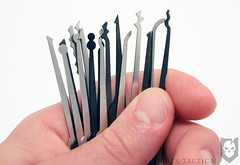
We hope this article will give a better understanding of the common types of picks available and the locks their best suited for. We provide this information purely from an educational standpoint, not an illegal one. We strongly believe this is an important skillset to have, and should be used appropriately.
Picks
- Small Hook – Hooks are designed to pick one pin at a time typically in pin and tumbler locks. They can also be used to “rake” over pins, but will scratch pins and leave footprints.
- Large Hook – Used for pin and tumbler locks that have larger tumblers. The longer reach is required to push the long tumblers past the shear line.
- Single Ball – Ball Picks are used in disc tumbler or wafer locks. The purpose is to be able to move the individual disc/wafer regardless of which direction it moves.
- Double Ball – Same as the single ball, and should be used when the single ball is giving you trouble.
- Small Half Diamond – Diamond Picks are used to pick pins that have little variation in length. Stick with the hook if you have big variations.
- Medium Half Diamond – Same as above, but with more height on the tip.
- Broken Key Extractor – As the name implies, this pick is to remove a key that has broken off in the lock. It has an aggressive tip to catch on the key fragment and yank it out.
- “C” Rake / Snake – This pick can be used when time is an issue. No pick is guaranteed to pick a lock quickly, but we’ve had good luck using this pick on typical household pin and tumbler locks. Rakes will generate more movement than a normal hook or diamond and can be jiggled or picked. Use heavy tension with this pick to allow more than one pin to bind at a time.
- “W” Rake / Snake – Similar in theory to the “C” Rake / Snake but with more aggressive angles.
- Snake/Diamond Double Sided Pick – Features something similar to a less aggressively cut “W” Rake/Snake on one end, and a shallower back-angle Half Diamond on the other end.
- “L” Rake – Made for jiggling under tension. Not as effective as other picks and should be used sparingly.
Tension Wrenches
The general rule with tension wrenches is to try it out in the lock before attempting to pick, to ensure it will fit correctly and turn the cylinder.
Instead of describing each tension wrench pictured to the right, we’ll just review the different styles (from left to right).
- The first is a variable tension wrench, which puts… yep, variable tension on the cylinder
- The next three tension wrench are traditional wrenches of various sizes
- Next is a “Twist-Flex” wrench, which increases the surface area where tension is being applied
- Further to the right is another traditional wrench with a slight bend to move the wrench arm further away from the lock
- Last is a Feather-Touch wrench which applies constant tension, at the cost of less “feeling” in the wrench
These lock picking tips and techniques provided in this article are only to be used in accordance with all local, state, and federal laws and provided for lock sport (recreational lock picking) use only. Lock sport should be used to learn about the illusion of security, and how to properly protect yourself and your possessions. Don’t do anything illegal.